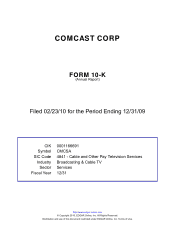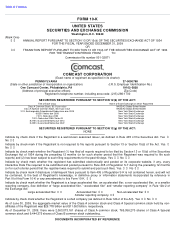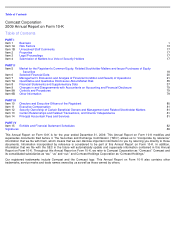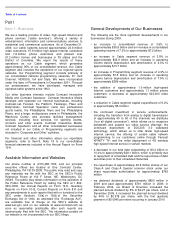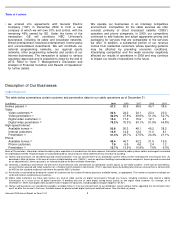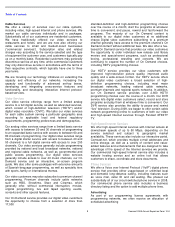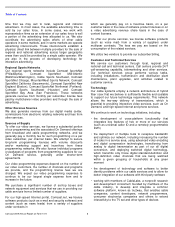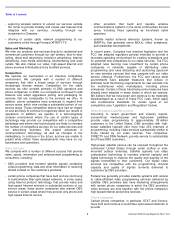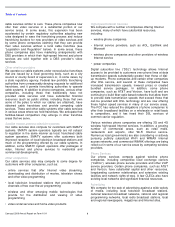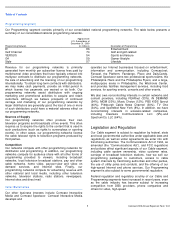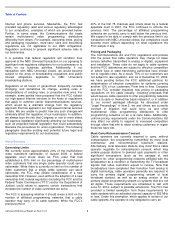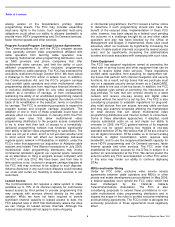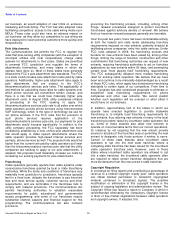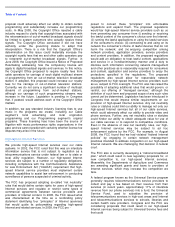Comcast 2009 Annual Report Download - page 7
Download and view the complete annual report
Please find page 7 of the 2009 Comcast annual report below. You can navigate through the pages in the report by either clicking on the pages listed below, or by using the keyword search tool below to find specific information within the annual report.
Table of Contents
Description of Our Businesses
Cable Segment
The table below summarizes certain customer and penetration data for our cable operations as of December 31.
Basis of Presentation: Information related to cable system acquisitions is included from the date acquired. Information related to cable systems sold or exchanged is excluded
for all periods presented. All percentages are calculated based on actual amounts. Minor differences may exist due to rounding.
(in millions)
2009
2008
2007
2006
2005
Homes passed
51.2
50.6
48.5
45.7
38.6
Video
Video customers
23.6
24.2
24.1
23.4
20.3
Video penetration
46.0
%
47.8
%
49.6
%
51.3
%
52.7
%
Digital video customers
18.4
17.0
15.2
12.1
9.1
Digital video penetration
78.2
%
70.3
%
63.1
%
51.9
%
44.8
%
High-speed Internet
Available homes
50.8
50.3
48.1
45.2
38.2
Internet customers
15.9
14.9
13.2
11.0
8.1
Penetration
31.4
%
29.7
%
27.5
%
24.4
%
21.1
%
Phone
Available homes
48.4
46.7
42.2
31.5
19.6
Phone customers
7.6
6.5
4.6
2.4
1.2
Penetration
15.7
%
13.9
%
10.8
%
7.6
%
6.0
%
(a)
Homes and businesses are considered passed (“homes passed”)
if we can connect them to our distribution system without further extending the transmission lines. As
described in Note (b) below, in the case of certain multiple dwelling units (“MDUs”),
such as apartment buildings and condominium complexes, homes passed are counted
on an adjusted basis. Homes passed is an estimate based on the best available information.
(b)
Generally, a dwelling or commercial unit with one or more television sets connected to our distribution system counts as one video customer. In the case of some MDUs,
we count homes passed and video customers on a Federal Communications Commission (
“FCC”)
equivalent basis by dividing total revenue received from a contract with
an MDU by the standard residential rate where the specific MDU is located.
(c)
Penetration is calculated by dividing the number of customers by the number of homes passed or available homes, as appropriate. The number of customers includes our
small and medium-sized business customers.
(d)
Digital video customers are those who receive any level of video service via digital transmissions through any means, including customers who receive a digital
transmission as a result of our all digital conversion. A dwelling with one or more digital set-
top boxes counts as one digital video customer. On average, as of
December 31, 2009, each digital video customer had 2.0 digital set-top boxes, including digital transport adapters (“DTAs”).
(e)
Homes and businesses are considered available (“available homes”)
if we can connect them to our distribution system without further upgrading the transmission lines
and if we offer the service in that area. Available homes for phone include digital and circuit-switched homes. See also Note (a) above.
Comcast 2009 Annual Report on Form 10-K
2
•
we entered into agreements with General Electric
Company (“GE”)
in December 2009 to form a new
company of which we will own 51% and control, with the
remaining 49% owned by GE. Under the terms of the
transaction, GE will contribute NBC Universal’
s
businesses, including its cable and broadcast networks,
filmed entertainment, televised entertainment, theme parks
and unconsolidated investments. We will contribute our
national programming networks, our regional sports
networks, other programming networks and certain of our
Internet businesses. The transaction is subject to various
regulatory approvals and is expected to close by the end of
2010. Refer to “Item 7: Management’
s Discussion and
Analysis of Financial Condition and Results of Operations
”
for further details.
We operate our businesses in an intensely competitive
environment. Competition for the cable services we offer
consists primarily of direct broadcast satellite (“DBS”)
operators and phone companies. In 2009, our competitors
continued to add features and adopt aggressive pricing and
packaging for services that are comparable to the services
we offer. In addition, a substantial portion of our revenue
comes from residential customers whose spending patterns
may be affected by prevailing economic conditions.
Intensifying competition and the weak economy negatively
affected our results of operations in 2009 and may continue
to impact our results of operations in the future.
(a)
(b)
(c)
(d)
(c)
(e)
(c)
(e)
(c)

